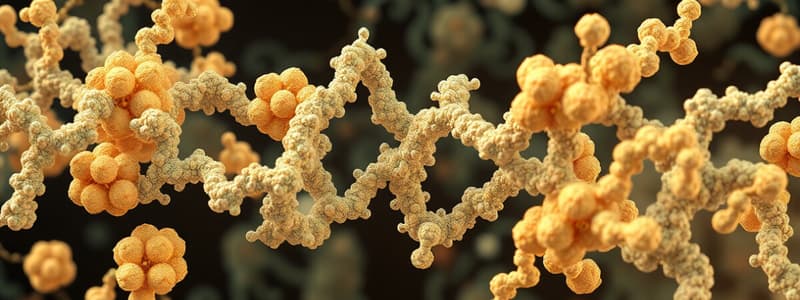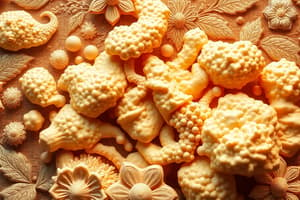Podcast
Questions and Answers
What is the primary function of enzymatic proteins?
What is the primary function of enzymatic proteins?
- To transport molecules across cell membranes
- To regulate physiological processes
- To provide structural support to cells
- To act as biological catalysts (correct)
Transport proteins are embedded in the plasma membrane to assist in signaling between cells.
Transport proteins are embedded in the plasma membrane to assist in signaling between cells.
False (B)
What is the role of regulatory proteins in the body?
What is the role of regulatory proteins in the body?
To regulate physiology and behavior through signaling molecules.
Hemoglobin is an example of a ___________ protein.
Hemoglobin is an example of a ___________ protein.
Match each type of protein to its function:
Match each type of protein to its function:
What is the primary function of antibodies?
What is the primary function of antibodies?
Structural proteins help maintain the structural integrity of living organisms.
Structural proteins help maintain the structural integrity of living organisms.
What type of protein is collagen?
What type of protein is collagen?
_____ helps form the tissues of hair, nails, and the outer layer of skin.
_____ helps form the tissues of hair, nails, and the outer layer of skin.
Which protein is responsible for movement and contractility in cells?
Which protein is responsible for movement and contractility in cells?
Match the following structural proteins with their descriptions:
Match the following structural proteins with their descriptions:
Elastin is known for its rigidity and resistance to stretching.
Elastin is known for its rigidity and resistance to stretching.
What do actin filaments primarily contribute to in cells?
What do actin filaments primarily contribute to in cells?
What is the primary function of storage proteins?
What is the primary function of storage proteins?
All proteins are made up of the same sequence of amino acids.
All proteins are made up of the same sequence of amino acids.
What type of bond forms between amino acids during the dehydration synthesis process?
What type of bond forms between amino acids during the dehydration synthesis process?
The primary structure of a protein refers to its specific sequence of _____.
The primary structure of a protein refers to its specific sequence of _____.
Match the following proteins with their types:
Match the following proteins with their types:
Which of the following is NOT a type of protein?
Which of the following is NOT a type of protein?
Amino acids contain a carboxyl group and an amino group.
Amino acids contain a carboxyl group and an amino group.
How many different amino acids are used to build proteins?
How many different amino acids are used to build proteins?
Which structure of proteins contains more than 1 amino acid chain?
Which structure of proteins contains more than 1 amino acid chain?
RNA contains the nitrogenous base thymine.
RNA contains the nitrogenous base thymine.
What are the two types of nucleic acids?
What are the two types of nucleic acids?
A nucleotide consists of a phosphate group, a pentose sugar, and a ______.
A nucleotide consists of a phosphate group, a pentose sugar, and a ______.
Which component is not part of a nucleotide?
Which component is not part of a nucleotide?
What type of RNA serves as a temporary copy of a gene?
What type of RNA serves as a temporary copy of a gene?
Match the following nitrogenous bases with their corresponding nucleic acid:
Match the following nitrogenous bases with their corresponding nucleic acid:
Which nitrogenous base is found in DNA but not in RNA?
Which nitrogenous base is found in DNA but not in RNA?
Flashcards are hidden until you start studying
Study Notes
Proteins
- Proteins are essential macromolecules that perform vital functions in the body, including structural roles and regulatory tasks.
- Composed of 20 different amino acids, proteins are long chains called polypeptides that vary in sequence and structure.
Types of Proteins
- Enzymatic Proteins (Enzymes): Biological catalysts that speed up chemical reactions by lowering activation energy.
- Regulatory Proteins: Often hormones, these proteins send signals to distant organs to regulate physiological functions and behavior.
- Transport Proteins: Located in the plasma membrane, they facilitate the movement of molecules across cell membranes (e.g., hemoglobin).
- Defense Proteins (Antibodies): Large Y-shaped proteins that play a crucial role in the immune system by neutralizing pathogens.
- Structural Proteins: Provide support and shape to cells and tissues; examples include collagen (for skin elasticity), keratin (in hair and nails), and elastin (in ligaments and arteries).
- Storage Proteins: Act as reservoirs of amino acids, used later for growth and development (e.g., albumin).
Structure of Amino Acids
- Amino acids comprise a central carbon atom bonded to an amino group (-NH2), carboxyl group (-COOH), hydrogen atom (-H), and a variable side group (R).
- The side chain determines the specific characteristics of each amino acid, being either hydrophilic or hydrophobic.
Linking Amino Acids
- Amino acids are linked through dehydration synthesis to form peptide bonds, creating a polypeptide chain.
Protein Structure Levels
- Primary Structure: The linear sequence of amino acids in a polypeptide.
- Secondary Structure: The folding of the polypeptide into alpha-helices or beta-pleated sheets.
- Tertiary Structure: Three-dimensional shape formed by interactions between R groups.
- Quaternary Structure: Assembly of multiple polypeptide chains into a functional protein.
Nucleic Acids
- Nucleic acids store hereditary information and encode the instructions for protein synthesis; two main types are DNA and RNA.
- Composed of nucleotides, each consisting of a phosphate group, a pentose sugar (deoxyribose in DNA, ribose in RNA), and a nitrogenous base.
Nucleotide Structure
- Nucleotides are linked via phosphodiester bonds, connecting the 5’ carbon of one nucleotide to the 3’ carbon of another, resulting in a directional strand (5’ to 3’).
RNA Functions
- RNA types include:
- mRNA (Messenger RNA): Carries the genetic code from DNA for protein synthesis.
- tRNA (Transfer RNA): Helps translate the genetic code into a sequence of amino acids.
- rRNA (Ribosomal RNA): Combines with proteins to form ribosomes and catalyze peptide bonds.
- RNA typically exists as a single-stranded molecule and is shorter than DNA.
Differences Between DNA and RNA
- Sugar: DNA contains deoxyribose; RNA contains ribose.
- Strands: DNA is double-stranded; RNA is single-stranded.
- Nitrogenous Bases: DNA has thymine; RNA has uracil instead. Both contain adenine, cytosine, and guanine.
- Location: DNA is found in the nucleus; RNA is mostly located in the cytoplasm.
Studying That Suits You
Use AI to generate personalized quizzes and flashcards to suit your learning preferences.




